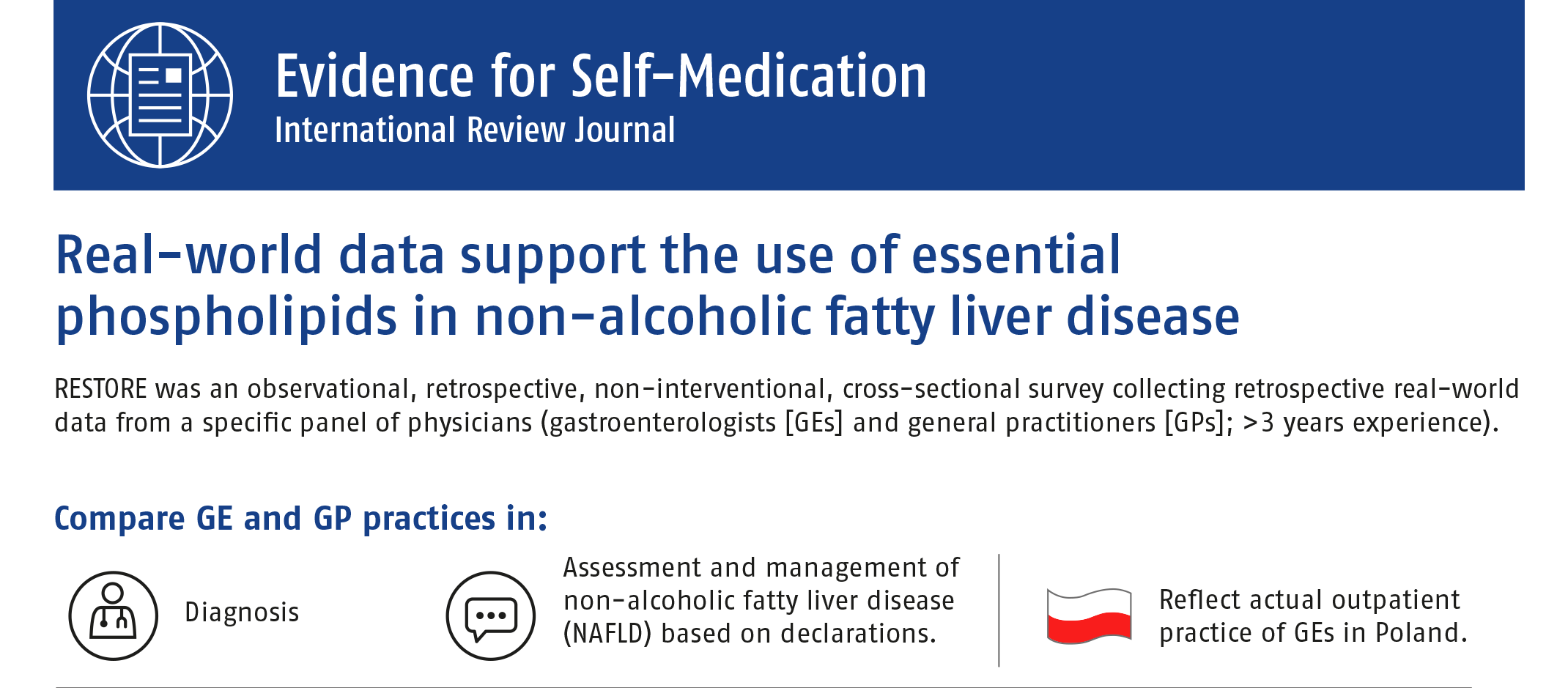RESTORE was an observational, non-interventional, retrospective, cross-sectional survey that collected real-world data from selected, experienced gastroenterologists (GEs) (n = 95) and general practitioners (GPs) (n = 115) in Poland [1]. The major aim of the survey of patients visiting GEs (n = 380) was, to record the most relevant symptoms related to NAFLD.
 Great Britain
Great BritainReal-world data support the use of essential phospholipids in non-alcoholic fatty liver disease
Gastroenterologists and general practitioners recommend essential phospholipids as adjunctive treatment in NAFLD
The key complaint bloating was recorded as a major symptom of NAFLD by both, GEs and GPs, to the same extent. However, GEs also assigned less obvious symptoms such as abdominal discomfort, drowsiness, fatigue or lack of energy to the diagnosis of NAFLD. In comparison, abdominal pain/discomfort and dyspepsia were the symptoms most frequently recorded by GPs. 89% of patients reported symptoms and 11% reported none. This demonstrates that NAFLD is not a silent/asymptomatic disease, since both, GEs/GPs and patients, report many non-specific symptoms.
With regard to treatment, GEs and GPs recommended switch of diet, change in lifestyle and/or supportive pharmacological therapy. The three most important criteria for the choice of pharmacotherapy were efficacy, tolerability and improvement in quality of life. The majority of GEs (92%) and GPs (98%) recommended essential phospholipids (EPLs) and rated these highest for tolerability (Tab. 1). For quality of life improvement, EPLs were ranked highest both by GEs and GPs. Other frequently recommended products were ursodeoxycholic acid, timonacic (thioproline, 1,3-thiazolidine-4-carboxylic acid), silibinin/silymarin and ornithine plus choline (Fig. 1).
From patient records (n = 302), the four most frequently recommended treatments (% patients) were: essential phospholipids (17%), timonacic (8%), silibinin/silymarin (6%), and ursodeoxycholic acid (5%). It is worth noting that an important symptom ‘lack of energy’ was relieved in 79% of patients with essential phospholipid treatment compared to 51% of patients receiving timonacic (p = 0.05, Chi-Square test).
Tab. 1. GE and GP ranking of tolerability of the top five pharmacological interventions prescribed for NAFLD [1]
| Treatment | Mean ranking scorea | |
| GEs (n = 95) | GPs (n = 115) | |
| Essential phospholipids | 4.5 | 4.6 |
| Silibinin/Silymarin | 4.4 | 4.4 |
| Timonacic | 4.4 | 4.3 |
| Ornithine + Choline | 4.3 | 4.2 |
| Ursodeoxycholic acid | 4.1 | 3.6 |
| a Physicians ranked each treatment using a scale from 1 (not tolerated at all) to 5 (extremely well tolerated). | ||
Fig. 1. The pharmacological treatments for NAFLD most commonly prescribed by gastroenterologists (GEs) and general practitioners (GPs) in Poland [1] Since NAFLD is a chronic disease, 59% of GEs and 62% of GPs recommended long-term treatment.
Patients benefit from adherence-promoting advice
In a questionnaire-based interview in 400 patients who had been taking EPLs (Essentiale®) for at least one month, patients were asked about the effectiveness of and satisfaction with the treatment [2]. Almost a quarter of them (23%) took EPLs as a result of their disease being diagnosed by their physician. This group of patients used the product more regularly (88% every day) than those who took the EPLs on their own initiative (77% every day). It is worth noting that only 5% of respondents used the recommended daily dose of 1800 mg essential phospholipids (Fig. 2).
Fig. 2. Percentages of respondents taking the specified daily doses of essential phospholipids (on the day of its intake). Respondent rates are shown as % (n = 400) [2]
Summary
In comparison to other important hepatoprotectants, physicians in Poland rank essential phospholipids as the best treatment option for NAFLD especially in terms of tolerability, efficacy, and improvement in quality of life. Patients derive particular benefit if they take their medication long-term and at the recommended dosage.
Literature
- Hartleb M, Mastalerz-Migas A, Kowalski P, Okopień B, Popovic B, Proga K and Cywińska-Durczak B Healthcare practitioners’ diagnostic and treatment practice patterns of non-alcoholic fatty liver disease in Poland: a cross-sectional survey. 2021. Eur J Gastroenterol Hepatol. doi: 10.1097/MEG.0000000000002288
- Kowalski P, Proga K, Cichy W Practice of hepatoprotective self-medication, with Essentiale use as an example – assessment of treatment efficacy and satisfaction. 2021. Świat Medycyny, Farmacji 42
Conflict of interest: B. Cywińska-Durczak and B. Popovic are employees of Sanofi.
Disclosures: Medical writing and publication funded by Sanofi.
Preview PDF Infographic

